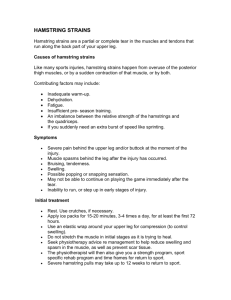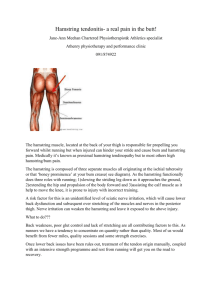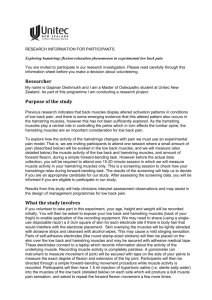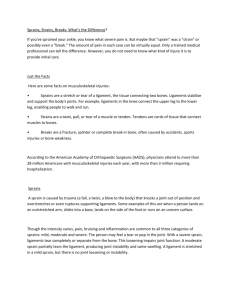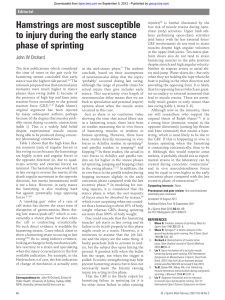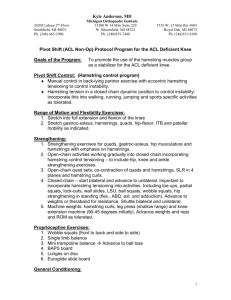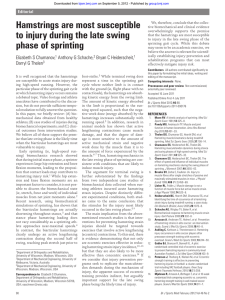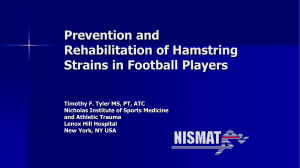Hamstring Strain
advertisement
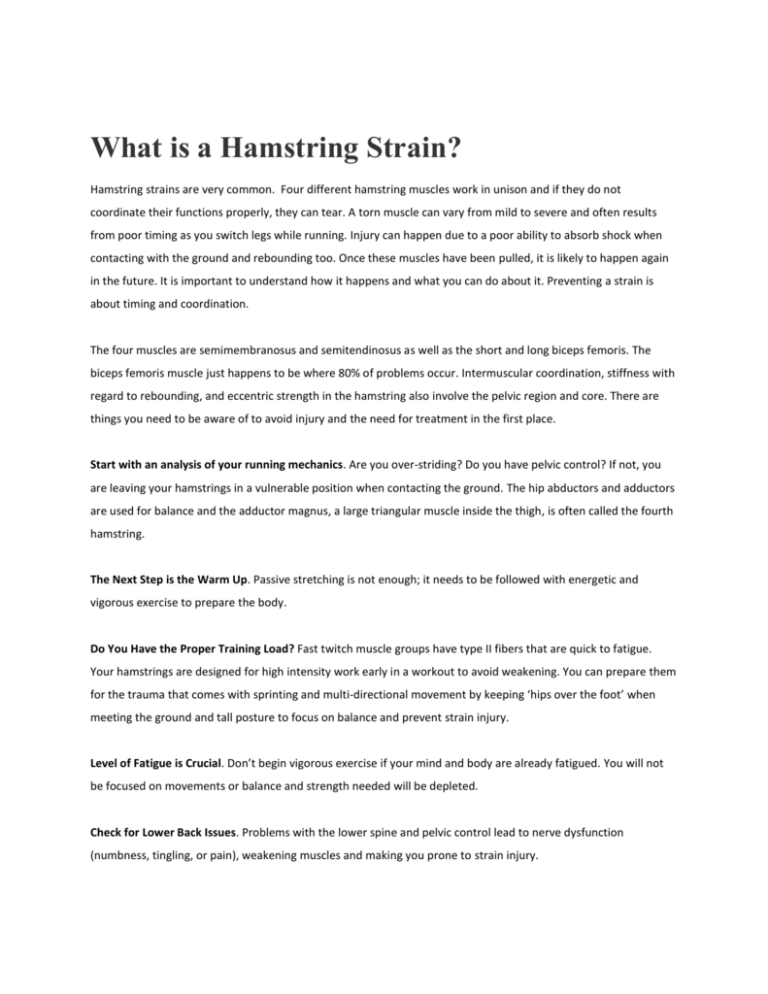
What is a Hamstring Strain? Hamstring strains are very common. Four different hamstring muscles work in unison and if they do not coordinate their functions properly, they can tear. A torn muscle can vary from mild to severe and often results from poor timing as you switch legs while running. Injury can happen due to a poor ability to absorb shock when contacting with the ground and rebounding too. Once these muscles have been pulled, it is likely to happen again in the future. It is important to understand how it happens and what you can do about it. Preventing a strain is about timing and coordination. The four muscles are semimembranosus and semitendinosus as well as the short and long biceps femoris. The biceps femoris muscle just happens to be where 80% of problems occur. Intermuscular coordination, stiffness with regard to rebounding, and eccentric strength in the hamstring also involve the pelvic region and core. There are things you need to be aware of to avoid injury and the need for treatment in the first place. Start with an analysis of your running mechanics. Are you over-striding? Do you have pelvic control? If not, you are leaving your hamstrings in a vulnerable position when contacting the ground. The hip abductors and adductors are used for balance and the adductor magnus, a large triangular muscle inside the thigh, is often called the fourth hamstring. The Next Step is the Warm Up. Passive stretching is not enough; it needs to be followed with energetic and vigorous exercise to prepare the body. Do You Have the Proper Training Load? Fast twitch muscle groups have type II fibers that are quick to fatigue. Your hamstrings are designed for high intensity work early in a workout to avoid weakening. You can prepare them for the trauma that comes with sprinting and multi-directional movement by keeping ‘hips over the foot’ when meeting the ground and tall posture to focus on balance and prevent strain injury. Level of Fatigue is Crucial. Don’t begin vigorous exercise if your mind and body are already fatigued. You will not be focused on movements or balance and strength needed will be depleted. Check for Lower Back Issues. Problems with the lower spine and pelvic control lead to nerve dysfunction (numbness, tingling, or pain), weakening muscles and making you prone to strain injury. Check the Ground Surface. Slippery and uneven surfaces will strain muscles as they correct themselves for balance. What Causes a Hamstring Strain? Primary causes involve poor intermuscular coordination due to timing and localized strength in the hamstring muscles when switching legs as feet contact the ground during recovery and approach while sprinting or running. Also, lack of localized muscle strength in the hamstrings, during the ground contact phase of running, affects the ability to absorb shock and rebound. There is a prior strain injury. What are the Symptoms of a Hamstring Strain? Mild strains feel more like a stiffness or dull ache in the hamstring. A higher grade strain is excruciating and walking or standing may be impossible. An accurate diagnosis requires further analysis. Other symptoms of hamstring strain injury are: A pop in the hamstring followed by sudden and agonizing pain during exercises Rear thigh and gluteal pain when walking, extending the leg, or leaning over Soreness Bruising How is a Hamstring Strain Diagnosed? What is the Recovery Time? Physiotherapists look for signs of pain when contracting the muscle, reduced flexibility, soreness or a substantial lump or gap within the muscle tissue. The strain is graded 1, 2, or 3 and will vary due to demands of activities. General recovery times will need further analysis by a physiotherapist. Grade 1 – There is tension in the back of the thigh, but able to walk normally. Discomfort causes an inability to run at full speed, mild swelling, and spasm of the muscle. Resistance while bending the knee is not likely to cause much pain. Recovery expected is 1 to 3 weeks. Grade 2 – Normal walking is affected and results in limping. Sudden spasms during exercises, some muscle swelling, and tenderness are typical. It is painful to bend your knee against resistance. Recovery expected is 4 to 8 weeks. Grade 3 - This is a severe strain injury involving a tear to half or more of the muscle. Crutches are needed due to terrible pain and weakening in the muscle. Swelling evident right away and bruising appears within 24 hours. Recovery is expected in 3 to 6 months and may require surgery. Grades of injury and exact location are found by your physician using diagnostic MRI. Your sciatic nerve passes through the hamstring muscle group, so a back injury, among others, pinching the sciatic nerve, can replicate the symptoms. Get a professional diagnosis from a physiotherapist skilled in treatment of these particular strain injuries. Hamstring Strain Treatment Many patients start feeling better within a few days of the injury. Re-injury rate is high because of poor rehabilitation processes. Specific exercise programs and treatments by a physiotherapist are recommended. Hamstring strains are one injury where expert analysis is recommended for an accurate diagnosis to provide you with the best chance of avoiding reoccurring injury and issues in the lower back and hips created by building scar tissue. Hamstring Physiotherapy Treatment Reducing pain and swelling Regulating range of flexibility and extension with stretching Strengthening the knees and thighs with exercises that train muscular stiffness and reactivity Reinforcing lower limb muscles like the calves and pelvis Normalizing core stabilization – a mitigating factor in many strains Focusing on communication in the nervous system enabling the sciatic nerve to pass freely without intrusion of scar tissue Improving the body’s overall ability to determine and react to position, motion, and equilibrium Developing your method and purpose when running, sprinting, jumping, hopping, and landing Diminish risk of re-injury and further treatment with proper exercises Avoiding surgery unless necessary in rare cases of complete rupture or to remove scar tissue from reoccurring tears. Some last minute changes made to this before leaving for Charleston
